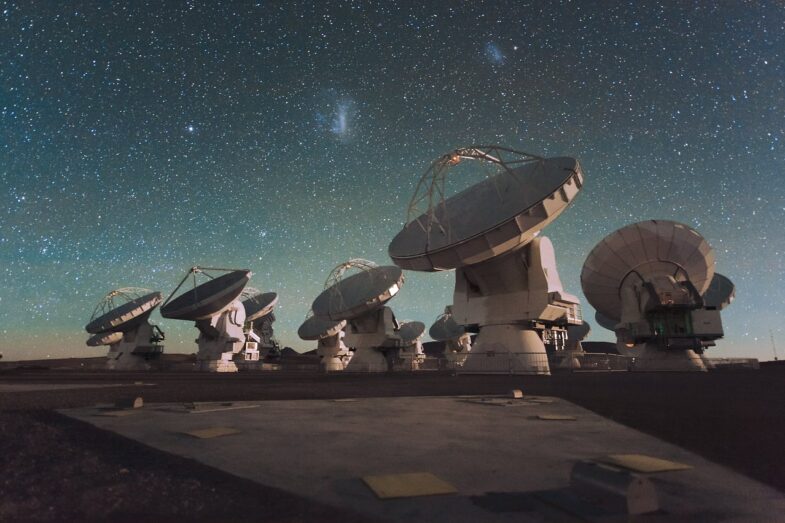
Haystack scientists to contribute to major ALMA correlator upgrade
The Atacama Large Millimeter/submillimeter Array (ALMA)—a radio telescope composed of 66 antennas spread across the Atacama desert in northern Chile—is currently the world’s most sensitive observatory operating at millimeter and submillimeter wavelengths. And it is about to get even more powerful, thanks to a plan to completely revamp the specialized supercomputer that serves as its “brain.”
ALMA is operated through an international partnership between the United States, 16 countries in Europe, Canada, Japan, South Korea, Taiwan, and Chile. These partners have recently approved the funds needed for upgrades to ALMA that will keep the observatory on the cutting edge well into the next decade. Among the planned improvements is the replacement of ALMA’s correlator, the essential supercomputer that coordinates the processing of data from its 66 individual antennas and enables astronomers to produce exquisitely detailed images of astronomical objects.
For the next five years, researchers from MIT Haystack Observatory will be working with the National Research Council of Canada (NRC) and the National Science Foundation’s National Radio Astronomy Observatory (NRAO) to upgrade ALMA’s correlator to supply the computing enhancements needed to further expand ALMA’s scientific prowess.
Haystack Observatory’s role will be focused on supporting a component of the correlator upgrade that allows the collection of ALMA dishes to operate as a “phased” array. In this special mode of operation, the telescopes are synchronized to function together like a single, giant antenna. Using a technique known as very long baseline interferometry (VLBI), this phased array can then join networks of telescopes around the world to operate together as an earth-sized telescope.
The inclusion of ALMA in global VLBI networks previously played a critical role in the Event Horizon Telescope (EHT)‘s first-ever imaging of two black holes, M87* and SgrA*. This next-generation correlator upgrade (known formally as the ALMA TALON Central Signal Processor, or AT.CSP) will provide another dramatic boost in ALMA’s efficiency, sensitivity, and bandwidth, and will allow it to obtain even more exquisite astronomical images of black holes and more.
For more on the Event Horizon Telescope historic, first-ever images of black holes, see MIT News:
(2) Astronomers snap first-ever image of supermassive black hole Sagittarius A*

“Phasing ALMA opened whole new possibilities for ultra high-resolution science, including enabling the first-ever images of black holes on event horizon scales,” says Haystack Principal Research Scientist Lynn Matthews, a member of the AT.CSP team. “And with the AT.CSP upgrade, these possibilities will continue to grow. We can look forward to the sharpest views yet of sources ranging from nearby stars to distant galaxies.”
The NRC story is available online.
The ALMA Phasing Project (APP)
VLBI is a technique that uses data from pairs of telescopes in combination to obtain a more detailed image than is possible with a single telescope. VLBI using ALMA as a partner site made possible the detailed black hole images described above. Haystack and ALMA are now looking forward to new discoveries that will be made possible by the new, more advanced correlator, in combination with an upgrade to ALMA’s bandwidth.
MIT Haystack Observatory’s longstanding role in the development of VLBI capabilities at ALMA began in 2011 with its leadership of the original ALMA Phasing Project (APP). This international effort developed the customized software and hardware needed to enable the synchronization, or phasing, of ALMA’s antennas with its current correlator. The ability of phased ALMA to join global VLBI networks resulted in an enormous boost in the ability of astronomers to produce images of astronomical sources with extraordinarily high angular resolution.
“ALMA was intended to be an evolving 30-year instrument; the planned upgrades should be at least as transformative as ALMA was at its birth. Truly, this is an exciting time to be alive.”
Geoff Crew, Haystack Research Scientist
Currently, Haystack is leading two follow-on programs (APP Phase 2 and APP Phase 3) that are continuing to introduce additional upgraded and advanced features to the ALMA array needed for VLBI and phased array science. These efforts are expanding the range of wavelengths at which ALMA can provide VLBI data, as well as the types of sources it can observe using VLBI techniques. These improvements are expanding the range of scientific possibilities with this technology. AT.CSP is now poised to provide the next major leap.